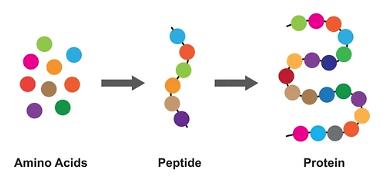Lifeasible specializes in providing services related to milk testing and offers services to help detect the amino acid content of milk and milk products.
Determination of amino acids in milk and milk products is essential. Proteins are composed of amino acids (Fig. 1). The proteins are broken down into amino acids before being absorbed by the body. Determining the amino acid profile in milk is essential for the qualitative evaluation of peptides and proteins that affect milk's chemical and nutritional properties. Different amino acids have different roles. For example, aspartic and glutamic acids act as neurotransmitters that regulate synaptic transmission and memory. Detecting these amino acids contributes to evaluating the nutritional function of milk and milk products. In addition, it is necessary to test for essential amino acids in milk that must be consumed from food.
 Fig. 1 Proteins are composed of amino acids.
Fig. 1 Proteins are composed of amino acids.
Lifeasible assists in the detection of amino acids in milk and milk products and provides professional services to help detect the profile of amino acids. We mainly base on ultra-high-performance liquid chromatography (UHPLC) for determining amino acids in milk and milk products, which is in accordance with international standards. We also use other methods to assist in the detection, including the fluorescence method, mass spectrometry method, and electrochemical detection method.
The method can detect a wide range of milk products, including whole milk, skim milk, infant formula, whole milk powder, and whey powder.
The method requires the protein to be acid hydrolyzed first and subsequently derivatized using 6-aminoquinolyl-N-hydroxy-succinimidyl carbamate (ACQ). Finally, the derivatives are separated and determined using UHPLC to determine the amino acid contents. The advantage of this method is that it can detect a wide range of amino acids at once, including essential amino acids (e.g., lysine, phenylalanine, and threonine) and non-essential amino acids (e.g., aspartic acid, cystine, glutamic acid). The disadvantage of this method is that it is not applicable to the determination of tryptophan.
Operation flow:

Main reference standard:
ISO 4214:2022
Fluorescence detection:
Amino acids do not fluoresce except for tryptophan, tyrosine, and phenylalanine. Therefore, they must be derivatized prior to fluorescence detection. Amino acid samples derivatized using AQC can be used for fluorescence detection to determine the content. The advantage of this method is the high detection sensitivity.
Mass spectrometry detection:
Mass spectrometry is the most used detection technique for amino acid analysis because of its high sensitivity and selectivity and its ability to be combined with separation techniques such as liquid chromatography (LC) and gas chromatography (GC) for analysis. In addition, mass spectrometry can directly detect amino acid samples obtained by hydrolysis.
Electrochemical detection:
In electrochemical analysis, derivatization is sometimes necessary to increase sensitivity. Electrochemical methods can also be combined with LC for amino acid determination to improve detection accuracy.
Note:
To detect tryptophan, we mainly use alkaline hydrolysis combined with fluorescence determination.
Lifeasible provides professional amino acid analysis services for milk and milk products, and we have advanced detection instruments and professional operators. We can achieve a comprehensive analysis of amino acids. Please contact us for cooperation!
References
Lifeasible has established a one-stop service platform for plants. In addition to obtaining customized solutions for plant genetic engineering, customers can also conduct follow-up analysis and research on plants through our analysis platform. The analytical services we provide include but are not limited to the following:
STU-CRISPR System Improves Plant Genome Editing Efficiency
April 19, 2024
Application of Exosomes in Facial Beauty
April 12, 2024